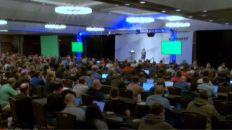For whatever reason, we all seem to live with the delusion that wireless networking works like a wired connection, but over the air. And, in that world, we also have leprechauns. The truth is the layer 1 (physical) properties of wireless and RF are completely different; polar opposites in some cases. And, in comparison to our long-loved wired technologies and standards, RF is inherently flawed in design, in many ways. I’ll address that another day. For now, let’s talk about the duplex properties of wireless. And by talk about them, I mean, discuss the lack of.
Wireless is half-duplex. Yep, let that sink in for just a minute before you keep reading. What it means is, something can talk, and it can listen, but it can’t do both at the same time. As an extension of that behavior, wireless has some unique anti-collision standards, specifically designed to address the screwy nature of RF. In a wired network, we can use collision detection, but in the air, our wireless stuff has no way to detect a collision, so the best they can do is make darn sure there isn’t a collision to detect, and so in wireless we have collision avoidance technologies employed.
The collision avoidance technologies in wireless bend over backwards to make sure things (ie wireless devices and APs) aren’t talking over one another.
 Imagine standing in a classroom of 50 students, with one person, the professor, on a podium at the front. The students need to speak to the professor, and the professor needs to hear each student with a question, but it must happen in turn. Comparable to how this happens over wireless medium, we have two ways to do this;
Imagine standing in a classroom of 50 students, with one person, the professor, on a podium at the front. The students need to speak to the professor, and the professor needs to hear each student with a question, but it must happen in turn. Comparable to how this happens over wireless medium, we have two ways to do this;
- a) students can raise their hands, and the professor acknowledges each, and calls on him or her to speak, or
- b) the students can look around the room, speak up when it’s quiet, and stop speaking if someone else starts at the same time.
The former is how RTS/CTS (request to send and clear to send) technologies work. The latter is comparable to CSMA/CA (carrier sense multiple access, with collision avoidance). Both are used in contemporary wireless LANs.
This is a short and rather crude explanation of the duplex and collision avoidance properties of wireless, but it should come in handy when seeking to understand complications with RF transmissions. I know most of you don’t care about the acronyms and IEEE standards, so here’s your brief explanation without the nitty gritty details .
# # #








